Jersey
 From Nwe
From Nwe | Bailiwick of Jersey Bailliage de Jersey |
||||||
|---|---|---|---|---|---|---|
|
||||||
| Anthem: "God Save the King" (official) "Ma Normandie" ("My Normandy") (official for occasions when distinguishing anthem required) |
||||||
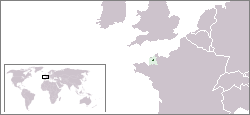
|
||||||
| Capital (and largest city) |
Saint Helier 49°11.401′N 2°06.600′W |
|||||
| Official languages | English, Norman (Jèrriais) and French[1] | |||||
| Ethnic groups (2021) | 44.4% Jersey 30.5% British 9.4% Portuguese 3.0% Polish 2.1% Irish 1.4% Romanian 5% Other European 1.9% Asian 0.9% African 1.3% multiracial[2] |
|||||
| Government | Parliamentary democratic constitutional monarchy | |||||
| - | Duke of Normandy | Charles III | ||||
| - | Lieutenant Governor | Jerry Kyd | ||||
| - | Bailiff | Tim Le Cocq | ||||
| - | Chief Minister | Kristina Moore | ||||
| Status | British Crown dependency | |||||
| - | Separation from mainland Normandy | 1204 |
||||
| - | Liberation from German occupation | May 9, 1945 |
||||
| Area | ||||||
| - | Total | 116 km² (219th) 45 sq mi |
||||
| - | Water (%) | 0 | ||||
| Population | ||||||
| - | 2021 estimate | 103,267[2] (182nd) | ||||
| - | Density | 859/km² 2,225/sq mi |
||||
| GDP (PPP) | 2015 estimate | |||||
| - | Total | billion (£4.57 billion)[3] (not ranked) | ||||
| - | Per capita | (£45,783) (not ranked) | ||||
| Currency | Pound sterling (GBP) |
|||||
| Time zone | (UTC±00:00) | |||||
| - | Summer (DST) | (UTC+01:00) | ||||
| Internet TLD | .je | |||||
| Calling code | [[++44 (usually +44-153)]] | |||||
| Patron saint | St. Helier | |||||
The Bailiwick of Jersey (Jèrriais: Jèrri) is a British Crown dependency off the coast of Normandy, France. The Bailiwick includes the uninhabited islands of the Minquiers, Écréhous, the Pierres de Lecq, and other rocks and reefs. Together with the Bailiwick of Guernsey it forms the grouping known as the Channel Islands.
The defense of all these islands is the responsibility of the United Kingdom. However, Jersey is not part of the UK, nor the European Union, but is a separate possession of the Crown, comparable to the Isle of Man. Jersey belongs to the Common Travel Area.
Jersey and the other Channel Islands represent the last remnants of the medieval Dukedom of Normandy that held sway in both France and England. These islands were the only British soil occupied by German troops in World War II.
The historic toleration of religious minorities has led to many persecuted minorities seeking refuge in Jersey. This has left a rich legacy of churches, chapels and places of worship. The established church is the Church of England.
Geography


Jersey is an island measuring 46 square miles (118.2 square kilometers), including reclaimed land and intertidal zone, which is about 0.7 times the size of Washington, DC in the United States.
It is located in the English Channel, approximately 12 nautical miles (22 kilometers from the Cotentin Peninsula in Normandy, France, and approximately 100 miles (140 kilometers) south of Great Britain. The States of Jersey is the largest and southernmost of the Channel Islands.
The island is a plateau mantled with wind-blown silt. It has a low-lying terrain on south coast, with some rocky headlands, rising gradually to rugged picturesque cliffs along the north coast. Coasts are reef-strewn, and a breakwater in St Aubin's Bay protects St Helier harbor. There are sand dunes along the west coast, and small valleys running north-south intersect the island. Very large tidal variation exposes large expanses of sand and rock to southeast at low tide. The highest point is Les Platons at 470 feet (143 meters).
The climate is temperate with mild winters and cool summers. The mean annual temperature is 52°F (11°C), and frost is rare. It also averages the most sunshine per year in the British Isles.
Gorse is one of Jersey's commonest large plants, the flowers of which create the blaze of gold on headlands and heaths in late spring and early summer. Gorse is often accompanied by dodder, a parasitic plant which draws sustenance from the gorse plant's spiky foliage.
Jersey has a population of reptiles and amphibians, including the common toad, Bufo bufo, and frogs, the green lizard, the wall lizard, the Jersey tiger moth, the white-toothed shrew, the herring gull, the stiff-winged fulmars, jet-black, green-eyed shags, larger-than-life black-backed gulls and clown-faced puffins. Offshore, there are herons, egrets, terns, curlews and even kingfishers to the list.
No natural hazards have been reported, although there are issues with waste disposal, air pollution, and traffic.
Three areas of land are protected for their ecological or geological interest as sites of special interest: Les Landes, Les Blanches Banques, and La Lande du Ouest. A large area of intertidal zone is designated as a Ramsar site. Jersey is the home of Durrell Wildlife (formerly known as the Jersey Zoological Park) founded by the naturalist, zookeeper, and author Gerald Durrell.
Saint Helier, one of the 12 parishes and the largest town in Jersey, had a population of about 28,000 in 2007, and is the capital, although Government House is situated in St Saviour. The parish Saint Helier covers a surface area of 4.1 square miles, being 9 percent of the total land area of the Island (this includes reclaimed land area of 494 acres).
History
Jersey history is influenced by its strategic location between the northern coast of France and the southern coast of England; the island's recorded history extends over a thousand years.
Prehistory

Jersey has been an island for approximately 8000 years. The earliest evidence of human activity dates to about 250,000 years ago when bands of nomadic hunters used the caves at La Cotte de St Brelade as a base for hunting mammoth. Settled communities appeared in the Neolithic period, which is marked by the building of the ritual burial sites known as dolmens. Archaeological evidence shows there were trading links with Brittany and the south coast of England during this time.
Roman influence

Evidence of bronze-age and early iron-age settlements can be found in many locations around the island. While archaeological evidence of Roman influence has been found, in particular the coastal headland site at Le Pinacle, Les Landes, where remains of a primitive structure are attributed to Roman temple worship (fanum), evidence for regular Roman occupation has yet to be established.
Christianity
The Channel Islands, then called the Lenur Islands, were occupied by the Britons during their migration to Brittany (fifth to sixth centuries). Various saints such as the Celt Samson of Dol and Branwaldr (Brelade) were active in the region, although tradition has it that it was Saint Helier from Tongeren in modern-day Belgium who brought Christianity to the Island in the sixth century, and Charlemagne sent his emissary to the island (then called Angia).
Normans
The name for Jersey is sourced to Viking activity in the area between the ninth and tenth centuries: the Norse suffix -ey for island can be found in many places around the northern European coasts. The Channel Islands remained politically linked to Brittany until 933 when William Longsword, Duke of Normandy, seized the Cotentin and the islands. In 1066 Duke William II of Normandy defeated Harold at Hastings to become king of England, although he continued to rule his French possessions as a separate entity.
The dukes of Normandy owned considerable estates on the island, and Norman families living there founded many of the Norman-French Jersey family names. King John lost all his territories in mainland Normandy in 1204 to King Philip II Augustus, but retained possession of Jersey, along with Guernsey and the other Channel Islands. The islands have been self-governing since.
The feudal age
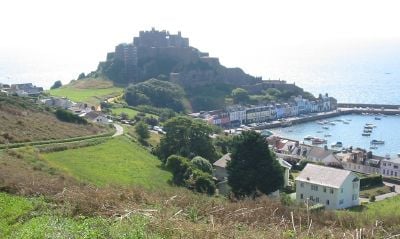
From 1204 onwards the Channel Islands became a potential flashpoint between England and France. In the Treaty of Paris (1253) the King of France gave up a claim to the Channel Islands based upon his position as feudal overlord of the Duke of Normandy. The King of England gave up claim to mainland Normandy and appointed a warden, a position now termed Lieutenant-Governor and a Bailiff to govern, although the Channel Islands were never formerly absorbed into the Kingdom of England.
Mont Orgueil castle was built at this time to serve as a Royal fortress and military base. During the Hundred Years' War the island was attacked many times, including twice in the 1338-1339 Channel campaign, and was occupied for a couple of years in the 1380s. During the Wars of the Roses the island was occupied by the French for seven years (1461-68) before Sir Richard Harliston arrived in the island to reclaim it for the English king. By the end of the fifteenth century, Jersey had its own captain, later called governor.
Protestantism adopted
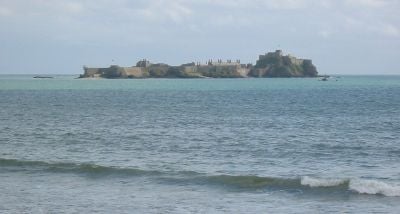
During the sixteenth century, the islanders adopted the Protestant religion and life became austere. The increasing use of gunpowder meant that a new fortress was built to defend Saint Aubin's Bay. The new Elizabeth Castle was thus named by Sir Walter Raleigh when he was governor. The island militia was reorganized on a parish basis and each parish had two cannons usually housed in the church - one of the St Peter cannons remains at the bottom of Beaumont Hill.

The production of knitwear reached such a scale that it threatened food production, so laws regulated who could knit with whom and when. The islanders became involved with the Newfoundland fisheries at this time. The boats left the island in February/March following a church service in St Brelade's church and they wouldn't return until September/October.
During the 1640s English Civil War, while islanders supported parliament, the de Carteret family, seigneurs of St Ouen, held the island for the king from 1643 to 1651. The future Charles II visited the island in 1646 and again in 1649 following the execution of his father. It was in the Royal Square in St. Helier on February 17, 1649, that Charles was first publicly proclaimed king after his father's death. Parliamentarian forces eventually captured the island in 1651. In recognition for all the help given to him during his exile, Charles II gave George Carteret, Bailiff and governor, a large grant of land in the American colonies, which he named New Jersey.
Towards the end of the seventeenth century Jersey strengthened its links with the Americas when many islanders emigrated to New England and north east Canada. The Jersey merchants built up a thriving business empire in the Newfoundland and Gaspé fisheries. Companies such as Robins and the Le Boutilliers set up thriving businesses.
Feuds, prosperity

Feuds between two political alignments, tore the island apart in the eighteenth and nineteenth centuries. Originating in the 1770s, the Jeannot party formed around the radical lawyer and Constable, Jean Dumaresq, who opposed the cabal of Jurats who surrounded Lieutenant Bailiff Charles Lemprière (whose supporters became known as the Charlot party). The Jeannots rapidly adopted the nickname of Magots (cheese mites) after their opponents boasted of aiming to crush them like mites. The progressive Magots adopted the rose as their emblem, while the conservative Charlots wore Bay laurel leaves. The symbolism soon became entrenched to the extent that gardens displayed their owners' allegiances, and pink or green paintwork also showed political sympathies.
Jersey prospered from the Newfoundland fisheries, privateering, and smuggling, and, later, from cattle, potatoes, and the tourist trade. The Code of 1771 laid down for the first time the extant laws of Jersey, and from this time the sole legislative power was vested in the States of Jersey.
Methodism arrives
Methodism arrived in Jersey in 1774, brought by fishermen returning from Newfoundland. Conflict with the authorities ensued when men refused to attend militia drill when that coincided with chapel meetings. The Royal Court attempted to proscribe Methodist meetings, but King George III refused to countenance such interference with liberty of religion. The first Methodist minister in Jersey was appointed in 1783, and John Wesley preached in Jersey in August 1789, his words being interpreted into the vernacular for the benefit of those from the country parishes. The first Methodist church was erected in St Ouen in 1809.
Invasions attempted
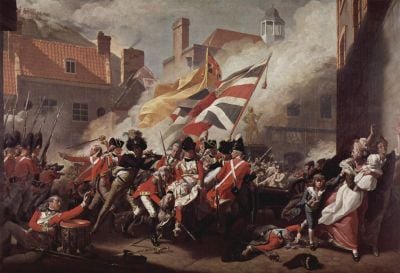
The eighteenth century was a period of political tension between Britain and France as the two nations clashed all over the world. Because of its position Jersey was more or less on a continuous war footing.
During the American Wars of Independence there were two attempted invasions of the island. In 1779 the Prince of Orange William V was prevented from landing at St Ouen's Bay; on January 6, 1781, a force lead by Baron de Rullecourt captured St Helier in a daring dawn raid, but was defeated by a British army led by Major Peirson. A short lived peace was followed by the French Revolutionary Wars and the Napoleonic Wars.
Economy grows
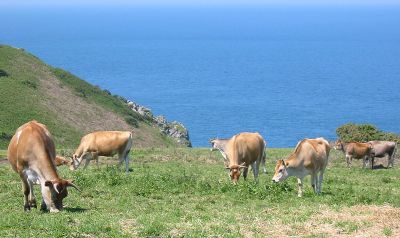
Military roads constructed (on occasion at gunpoint) by the governor, General George Don, to link coastal fortifications with St Helier harbor unexpectedly boosted the economy once peace restored reliable trade links. Farmers in previously isolated valleys were able to transport crops grown in the island's microclimate swiftly to waiting ships, and then on to the markets of London and Paris ahead of the competition.
Until the nineteenth century, cider was the largest agricultural export with up to a quarter of the agricultural land given over to orchards. In 1839, 268,199 gallons of cider were exported to England alone, but by 1870, when beer became a more popular drink, cider exports from Jersey had slumped to 4632 gallons. Potatoes overtook cider as the most important export in the 1840s.
In the late nineteenth century, island farmers benefited from the development of the Jersey cow and the Jersey Royal potato. Jersey cattle, the product of selective breeding, are a small, honey-brown breed of dairy cattle, renowned for the high butterfat content of its milk, as well as a genial disposition.
Jersey became one of the largest wooden ship-building areas in the British Isles, building over 900 vessels around the island.

The number of English speaking soldiers stationed in the island, and the number of retired officers and English speaking laborers who came to the islands in the 1820s, meant the island gradually moved towards an English-speaking culture. The nineteenth century brought the rise of tourism.
German occupation
The Channel Islands were occupied by German troops between 1940 and 1945, resulting in the evacuation of about 8,000 islanders, deportation of more than 1,200 islanders to camps in Germany and mainland Europe. Twenty died as a result. The islanders endured near-starvation in the winter of 1944-1945, cut off from German-occupied Europe by Allied forces advancing from the Normandy beachheads. Liberation Day - May 9 - is marked as a public holiday. The Channel Islands were the only British soil occupied by German troops in World War II.
Politics


Structure
The politics of the Bailiwick of Jersey take place in a framework of a parliamentary representative democratic British crown dependency. The government of Jersey is composed of the King of the United Kingdom, the Lieutenant Governor of Jersey, the bailiff, the assembly of the states, and since December 2005, the chief minister of Jersey and his cabinet. Charles III's traditional title as head of state is that of Duke of Normandy, although he reigns by his position as King over a crown dependency. His representative, the lieutenant governor, has little but a token involvement in politics.
The monarch is hereditary, while the lieutenant governor and bailiff are appointed by the monarch. A cabinet has existed since December 2005, consisting of ministers, including the chief minister, all of whom are elected by the Assembly of States.
Jersey's legislature is the unicameral assembly of the States of Jersey. It has 58 seats, 55 of whom are voting members, of which 12 are senators elected for six-year terms, 12 are constables or heads of parishes elected for three-year terms, 29 are deputies elected for three-year terms. The bailiff, the deputy bailiff, and three non-voting members includes the dean of Jersey, the attorney general, and the solicitor general appointed by the monarch. Elections were last held October 19, 2005, for senators, and November 23, 2005, for deputies. The next were to be held in 2008.
All current assembly members have been elected as independents. Formally constituted political parties are unfashionable, although groups of "like-minded members" act in concert. The Jersey Democratic Alliance is the only party with assembly members in 2007, although these were elected as independents. The Centre Party (Jersey) only proposes candidates for senatorial elections, though members are free to, and have, stood as independents.
The legal system is based on Norman customary law (including the Clameur de Haro), statute and English law. Justice is administered by the Royal Court consisting of the bailiff as chief magistrate and 12 jurats chosen by an electoral college.
Parishes
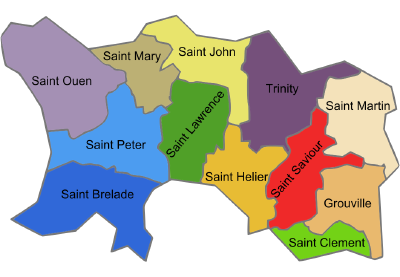
Administratively, Jersey is divided into 12 parishes. All have access to the sea and are named after the saints to whom their ancient parish churches are dedicated. They are: Grouville (historically Saint Martin de Grouville, incorporating Les Minquiers), Saint Brélade, Saint Clement, Saint Helier, Saint John, Saint Lawrence, Saint Martin (historically Saint Martin le Vieux; incorporating Les Écréhous), Saint Mary, Saint Ouen, Saint Peter, Saint Saviour, and Trinity. The parishes are further divided into vingtaine]s (or, in St. Ouen, cueillettes), divisions which are historic and nowadays mostly used for local administration and as electoral constituencies.

The constable (Connétable) is the head of each parish, elected at a public election for a three-year term to run the parish and to represent the municipality in the assembly. Elected procureur du bien public (two in each parish) are the legal and financial representatives of the parish. Centeniers are elected for a term of three years to undertake policing.
International relations
Although diplomatic representation is reserved to the Crown, Jersey negotiates directly with foreign governments on matters within the competence of the States of Jersey. Jersey is a member of the British-Irish Council, the Commonwealth Parliamentary Association and the Assemblée parlementaire de la Francophonie. In a survey of 700 people carried out by Channel Television in the summer of 2000, 68 percent supported independence from the United Kingdom. Senator (now Deputy) Paul le Claire lodged a project calling for Jersey's independence shortly thereafter. In June 2007, Jersey signed an agreement regarding the exchange of information relating to tax matters.
Economy

Jersey's economy is based on international financial services, agriculture, and tourism. Potatoes, cauliflower, tomatoes, and especially flowers are important export crops, shipped mostly to the UK. The Jersey breed of dairy cattle is known worldwide and represents an important export income earner. Milk products go to the UK and other EU countries. In recent years, the government has encouraged light industry to locate in Jersey, with the result that an electronics industry has developed alongside the traditional manufacturing of knitwear. All raw material and energy requirements are imported, as well as a large share of Jersey's food needs. Light taxes and death duties make the island a popular tax haven. Living standards come close to those of the UK.
Due to specialization in a few high return sectors, Jersey has very high economic output per capita, substantially ahead of all of the world's large developed economies.
Major agricultural products are potatoes and dairy produce. The source of milk is Jersey cattle. Small-scale organic beef production has been reintroduced in an effort to diversify the industry.
Taxation

Until the twentieth century, Jersey relied on indirect taxation. The levying of duties was transferred to the assembly in 1921, leaving the Assembly of Governor, Bailiff and Jurats to license the sale of alcohol. The Income Tax Law of 1928 introduced income tax, that has been levied at a flat rate of 20 percent for decades.
As VAT has not been levied in the island, low-value luxury items, such as videos, lingerie and contact lenses are exported to the UK, avoiding VAT on arrival and thus undercutting UK prices on the same products. In 2005, the States of Jersey announced limits on licenses granted to non-resident companies trading in this way.
The absence of VAT meant luxury goods have often been cheaper than in the UK or in France, providing an incentive for tourism from neighboring countries. In May 2005, the States of Jersey approved the introduction of a goods and services tax, scheduled for 2008.

Currency
Jersey issues its own banknotes and coins which circulate with UK coinage, Bank of England notes, Scottish notes, and Guernsey currency within the Island.
Pound coins are issued, but are much less widely used than pound notes. Designs on the reverse of Jersey pound coins include historic ships built in Jersey and a series of the twelve parishes' crests. The motto round the milled edge of Jersey pound coins is Insula Caesarea (Latin: "Island of Jersey"). Two pound coins are issued in small quantities.
Demographics
Population
Censuses have been undertaken in Jersey since 1821. Approximately one third of the population live in Saint Helier, the island's only town. Only half the island's population was born in Jersey; the majority of the others were born elsewhere in the British Isles.
The people of Jersey are often called Islanders or, in individual terms, Jerseyman or Jerseywoman. Some Jersey-born people identify as British.
The people of Jersey are often called islanders, or in individual terms Jerseyman or Jerseywoman. Most Jersey-born people consider themselves British and value the special relationship between the British Crown and the island.
Religion
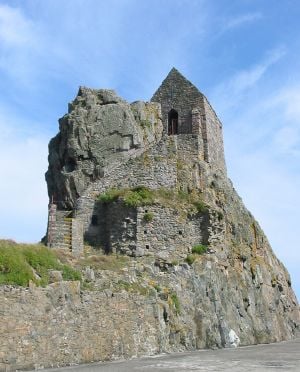
Religion in Jersey has a complex history and much diversity. The historic toleration of religious minorities has led to many persecuted minorities seeking refuge in Jersey. This has left a rich legacy of churches, chapels and places of worship. The established church is the Church of England. In the countryside, Methodism found its traditional stronghold. A minority of Roman Catholics can also be found in Jersey, with two Catholic private schools (De La Salle College in Saint Saviour being an all-boys Catholic school, and Beaulieu Convent School down the road in Saint Helier being an all-girls school where the sisters still have a presence in school life). The island's patron saint is Saint Helier.
Language

Until the nineteenth century, indigenous Jèrriais—a variety of Norman French—was the language of the island, though French was used for official business. Since 1900, English has been permitted in debates in the States of Jersey and has come to dominate. During the twentieth century, however, a language shift took place and Jersey became predominantly English-speaking. Jèrriais nonetheless survives. There have been efforts to revive Jèrriais in schools, and the highest number of declared Jèrriais speakers is in the capital.
The dialects of Jèrriais differ between parishes, with the most marked differences to be heard between those of the west and east. Many place names are in Jèrriais, and French and English place names are also to be found. Anglicization increased apace with the migration of English people to the island. The characteristic accent of Jersey English is rapidly being lost due to the influence of media and education.
Education

There are 22 non-fee-paying, two fee-paying, and five private primary schools, while there are four non-fee-paying and two fee-paying, and three private secondary schools. There are four schools catering for children with special needs. Each secondary school and some primary schools have further provision for children with particular needs.
Highlands College is the only further, higher and adult education college in Jersey. The Jersey Business School is a constituent part of the college. Highlands is a partner college of the University of Plymouth.
Culture

The culture of Jersey has been shaped by Jersey's indigenous Norman language and traditions as well as French and British influences, with input from immigrant Bretons and the Portuguese.
Art


Only fragmentary wall-paintings remain from a rich medieval artistic heritage, after the wholesale iconoclasm of the Calvinist reformation of the sixteenth century. The most notable of these are the wall-paintings of the Fisherman's Chapel (la Chapelle ès Pêcheurs) in St. Brelade.
The 1751 statue of George II by John Cheere in the Royal Square was Jersey's first public sculpture since the Reformation. John Singleton Copley's painting of the Battle of Jersey (January 6, 1781), "The Death of Major Pierson," became a national icon.
John Le Capelain (1812-1848), the son of Samuel Le Capelain, a printer and lithographer, who lived all his life in St Helier, is best known for his watercolors, although he had earlier followed his father in lithography.
Sarah Louisa Kilpack (1839-1909), an English artist who moved to Jersey, is noted for seascapes and coastal scenes, often stormy.
The "Glass Church" (St Matthew's, Millbrook, St Lawrence) is decorated with Art Deco glass by René Lalique, commissioned by Florence, Lady Trent, the Jersey-born wife of Lord Trent, founder of Boots Chemists.
Edmund Blampied (1886-1966), illustrator and artist, is the most popular Jersey artist of the twentieth century. Other artists include portrait painter John St. Helier Lander (1869-1944), a painter of marine subjects Philip John Ouless (1817-1885), portrait painterWalter William Ouless (1848-1933), stained glass artist Henry Bosdet (1857-1934), painter Sir Francis Cook (1907-1978), and photographers Suzanne Malherbe and Claude Cahun, the "Surrealist Sisters."
Cinema
In 1909, T.J. West established the first cinema in the Royal Hall in St. Helier, which became known as West's Cinema in 1923 (demolished 1977). The Jersey Film Society was founded in 1947 at the Café Bleu, West's Cinema. The first talking picture, The Perfect Alibi, was shown on December 30, 1929, at the Picture House in St Helier. The large Art Deco Forum Cinema was opened in 1935—during the German Occupation this was used for German propaganda films. The Odeon Cinema (now the New Forum) was opened in 1952. Since 1997, Kevin Lewis (formerly of The Cine Centre and now of the New Forum) has arranged the Jersey Film Festival, a charity event showing the latest and also classic films outdoors in 35 mm on a big screen.
Food and drink


Seafood has traditionally been important to the cuisine of Jersey: mussels (called moules locally), oysters, lobster and crabs—especially spider crabs which are considered a particular delicacy. Razor-fishing, sand-eeling and limpeting used to be popular activities. Ormers, being highly sought after, are conserved and fishing is restricted. Another seafood specialty is conger soup.
Cream and butter from rich Jersey milk, have played a large part in the cuisine, although there is no indigenous tradition of cheese making. Jersey fudge, mostly imported and made with milk from overseas Jersey cattle herds, is a popular food product with tourists.
Jersey Royal potatoes are the local variety of new potato, and the island is famous for its early crop of small potatoes from the south-facing côtils (steeply-sloping fields).
Apples were an important crop. Bourdélots are apple dumplings, but the most typical specialty is black butter (lé nièr beurre), a dark spicy spread prepared from apples, cider and spices.


Bean crock (les pais au fou) is a slow-cooked pork and bean stew, often containing a pig's trotter. In the past, the dish was so ubiquitous that English-speaking visitors believed that the people of Jersey ate nothing else, and dubbed the inhabitants Jersey beans.
Jersey wonders (les mèrvelles), a sort of rich twisted doughnut, is made less in the home than formerly but is still a popular treat at fairs and festivals. According to tradition, the success of cooking depends on the state of the tide. A sort of wonder poached in milk is known as a fliotte (eune fliotte).
Cabbage loaf is the traditional Jersey bread baked between two cabbage leaves. Vraic buns are very large sweet buns with raisins, and were traditionally eaten when men went out vraicking (collecting seaweed) on the shore. Among other traditional dishes are fliottes, nettle (ortchie) soup, vraic buns.
Cider used to be an important export. After decline and near-disappearance in the late twentieth century, apple production is being increased and promoted. Apple brandy is also produced, as is some wine.
Folklore and customs

Jersey people are traditionally known as crapauds (toads) due to the particular fauna of Jersey that does not exist in the other Channel Islands, especially in Guernsey. According to a Guernsey legend, St Samson of Dol arrived in Jersey but encountered such a hostile reception in the then-pagan island that he proceeded on to Guernsey. The welcome being much warmer in Guernsey, he repaid the inhabitants of that island by sending all the snakes and toads from Guernsey to Jersey.
The Battle of Flowers is a carnival, held annually in August. First held for the coronation of Edward VII in 1902, the carnival includes a parade of floral decorated floats. Originally, these floats were torn apart to provide floral ammunition for a battle of flowers between participants and spectators, but this aspect has long been abandoned.
Belief in witchcraft was strong in Jersey, and survived in country areas well into the twentieth century. Witches were supposed to hold their sabbats on Fridays at Rocqueberg, the Witches' Rock, in St Clement. Folklore preserves a belief that witches' stones on old houses were resting places for witches flying to their meetings.
Literature



Literature in Jersey may be divided into literature in Jèrriais, Francophone literature, and literature in English.
The literary tradition in Jersey is traced back to Wace (c. 1115 – c. 1183), an Anglo-Norman poet, who was born in Jersey and brought up in mainland Normandy, ending his career as Canon of Bayeux. His extant works include: Roman de Brut - a verse history of Britain, Roman de Rou - a verse history of the Dukes of Normandy, and, also in verse, lives of Saint Margaret and Saint Nicholas.
Printing arrived in Jersey in the 1780s, and the island supported a multitude of regular publications in French (and Jèrriais) and English throughout the nineteenth century, in which poetry, most usually topical and satirical, flourished.
The earliest identified dated example of printed poetry in Jèrriais is a fragment by Matchi L'Gé (Matthew Le Geyt 1777–1849), dated 1795. The first printed anthology of Jèrriais poetry, Rimes Jersiaises, was published in 1865.
Influential writers include 'Laelius' (Sir Robert Pipon Marett 1820–1884, Bailiff of Jersey 1880–1884), 'A.A.L.G.' (Augustus Aspley Le Gros 1840–1877), and 'St.-Luorenchais' (Philippe Langlois 1817–1884).
During the Occupation, little original writing was permitted to be published by the German censors. However, many older pieces of literature were re-published in the newspapers.
The most influential writer of Jèrriais in the twentieth century was a U.S. citizen, George Francis Le Feuvre (1891–1984), whose pen-name was "George d'la Forge." He emigrated to North America after the First World War but for almost 40 years maintained a flow of articles in Jèrriais back to Jersey for publication in newspapers.
The famous French writer Victor Hugo lived in exile in Jersey from 1852 to 1855.
Music and dance
The traditional folk music of Jersey was common in country areas until the mid-twentieth century. Most surviving traditional songs are in French, with some in Jèrriais, and in English Only one folk song is believed to be of specifically Jersey provenance is “La Chanson de Peirson.”
Little survives of indigenous musical or dance traditions. There were archaic dance-forms such as the "ronde" or round dance, eighteenth-century dances such as the cotillion, and nineteenth-century forms such as the polka, the schottische and the quadrille. Dances such as the "Gigoton" and "La Bébée" are both forms of polka. The violin, the chifournie (hurdy-gurdy), and later the accordion were traditional instruments for sonneurs (country dances).
Among contemporary music events is Jersey Live. Every year in Howard Davis park Jersey hosts its annual music festivals including Rock in the Park and its newly named Avanchi presents Jazz in July.
Performing arts
The annual Jersey Eisteddfod provides a platform for competition in music, drama and speaking in English, French and Jèrriais. The Opera House, opened by Lillie Langtry in 1900, and the Jersey Arts Centre are the main performance spaces, although many concerts and other cultural events take place in parish halls and other venues. Lillie Langtry, the Jersey Lily, is the island's most widely recognized cultural icon.
Sport
Jersey participates in its own right in the Commonwealth Games, in which shooting is a strong sport. Golf is also popular - Harry Vardon was a Jerseyman. Jersey participates in the Island Games, which it has hosted. Jersey sportspeople compete in the British Home Nations competitions. The Muratti football match against Guernsey is one of the sporting highlights of the year. There are several rugby clubs in the island including a rugby academy for under 18s and Les Quennevais Rugby Club.
Notes
- ↑ Jersey does not have a de jure official language, but these are the permitted languages in the island's parliament, the States Assembly
- ↑ 2.0 2.1 2021 census results Government of Jersey. Retrieved October 16, 2022.
- ↑ Measuring Jersey's Economy Government of Jersey. Retrieved October 16, 2022.
References
ISBN links support NWE through referral fees
- Balleine, G. R., Marguerite Syvret, and Joan Stevens. Balleine's History of Jersey. Chichester, Sussex, England: Phillimore, 1981. ISBN 978-0850334135
- Kelleher, John D. The triumph of the country: the rural community in nineteenth-century Jersey. Jersey, Channel Islands: John Appleby Pub. in association with Société jersiaise, 1994. ISBN 978-0951816240
- Sinel, L. P., and R. M. Mollet. Jersey through the centuries: a chronology of events and matters of interest. La Haule: La Haule Books, 1984. ISBN 978-0861200016
External links
All links retrieved October 16, 2022.
- Jersey Encyclopaedia Britannica
- States of Jersey Government of Jersey
- Jersey, Channel Islands
- Jersey BBC News
- Jersey Evening Post
- Jersey The World Factbook
Credits
New World Encyclopedia writers and editors rewrote and completed the Wikipedia article in accordance with New World Encyclopedia standards. This article abides by terms of the Creative Commons CC-by-sa 3.0 License (CC-by-sa), which may be used and disseminated with proper attribution. Credit is due under the terms of this license that can reference both the New World Encyclopedia contributors and the selfless volunteer contributors of the Wikimedia Foundation. To cite this article click here for a list of acceptable citing formats.The history of earlier contributions by wikipedians is accessible to researchers here:
- Jersey history
- Saint_Helier history
- History_of_Jersey history
- Occupation_of_the_Channel_Islands history
- Politics_of_Jersey history
- Economy_of_Jersey history
- Demographics_of_Jersey history
- Religion_in_Jersey history
- Culture_of_Jersey history
The history of this article since it was imported to New World Encyclopedia:
- History of "Jersey"
Note: Some restrictions may apply to use of individual images which are separately licensed.
↧ Download as ZWI file | Last modified: 02/04/2023 00:35:42 | 54 views
☰ Source: https://www.newworldencyclopedia.org/entry/Jersey | License: CC BY-SA 3.0
 ZWI signed:
ZWI signed:

 KSF
KSF